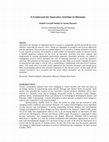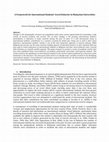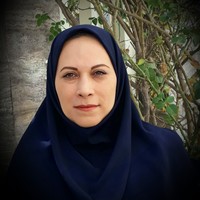Papers by Hanieh Varasteh

Psychological Studies, 2016
A primary objective of education is to prepare individuals to be effective learners. This entails... more A primary objective of education is to prepare individuals to be effective learners. This entails developing the cognitive, motivational, and metacognitive knowledge. From the perspective of educational psychology, existing psychological paradigms present diverse visions of the nature of the learner. To be an effective learner, as Jarvis (2005) contended, involves adopting an eclectic position and developing an adequate level of each paradigm. This study is an attempt to identify and examine the interrelationship among a host of cognitive, motivational, and metacognitive variables within a single framework. In particular, task value, metacognitive self-regulation, and ambiguity tolerance and their role in predicting learner's test anxiety, learning strategies, and language achievement were studied. The participants included 180 English as foreign language (EFL) learners with M.A. and B.A. degrees from a university in Mashhad, Iran. To measure the variables, two sets of questionnaires were employed. Task value, metacognitive self-regulation, test anxiety, and learning strategies were assessed through the Motivated Strategies for Learning Questionnaire (MSLQ) developed by Pintrich et al. (1993). To gauge ambiguity tolerance, the Ambiguity Tolerance in Second Language Learning Questionnaire (SLAT) designed by Ely (1995) was utilized. The results estimated via structural equation modeling (SEM) revealed that learners' self-regulation had a significant influence on language achievement. There was also a positive and direct association between cognitive components and metacognitive components. Additionally, it was found that the students' motivational components had a significant association with cognitive components. Finally, motivational and cognitive factors indirectly influenced on language achievement.
Anatolia, 2013
The accuracy of the Content should not be relied upon and should be independently verified with p... more The accuracy of the Content should not be relied upon and should be independently verified with primary sources of information. Taylor and Francis shall not be liable for any losses, actions, claims, proceedings, demands, costs, expenses, damages, and other liabilities whatsoever or howsoever caused arising directly or indirectly in connection with, in relation to or arising out of the use of the Content.

Changes in the demographic structure of a population make many various opportunities for presenti... more Changes in the demographic structure of a population make many various opportunities for presenting a wide variety of tourism products and services. One of these changes is the growing international student’s participation in education in many countries during the past 10 years. It is well documented owing to international students’ contribution to a country’s economy by tuition fees, living cost as well as their travel behaviors; international students’ market is one of the most important segments in tourism industry. While Malaysia has become one the main countries leading exporter of education however to date relatively little has been paid to travel preferences of international students in Malaysia and their travel behaviors have received little attention as a specific market segment. This paper proposes to present a review of academic articles that have been published about travel behaviors of students, particularly universities’ international students. This article examines the significance of international students to the tourism industry followed by a discussion of the limitations in the literature. The main goal of this article is to identify major variables involved in the identifying international students’ travel behaviors and develop a general framework for the determining of international students’ travel behavior in Malaysia.

Anatolia, 2014
This article focuses on determining the travel behaviour of international students studying in Ma... more This article focuses on determining the travel behaviour of international students studying in Malaysia. Questionnaire surveys on a total of 409 international postgraduate students of research universities (UPM, USM, UM, UTM, and UKM) in Malaysia were carried out. The results show that most of the international students had a tendency for travelling during semester breaks, staying in hotels, eating at fast food restaurants, and travelling with their friends for the purpose of having fun, and exploring new places. Sightseeing and shopping were identified as the most preferred activities by students and primary sources of information regarding potential destinations by international students include the Internet and friends' recommendations. This study also found that the travel behaviour of the different students is strongly associated with their demographic characteristics.

Journal of Vacation Marketing, 2014
This article attempted to find out important factors influencing international students’ travel b... more This article attempted to find out important factors influencing international students’ travel behavior. A total of 409 international postgraduate students studying in five Malaysian research universities (Universiti Putra Malaysia, Universiti Malaya, Universiti Teknologi Malaysia, Universiti Sains Malaysia, and Universiti Kebangsaan Malaysia) participated in this quantitative study through a self-administered questionnaire. A structural equation modeling–partial least squares using Warp PLS 3.0 was applied to analyze data. The study revealed that a number of demographic characteristics including age, marital status, nationality, and source of finance significantly affect preferred travel activities and preferences. In addition, travel behavior (as a third-order factor) was also affected by age, marital status, nationality, and source of finance. The moderating effect of information source on relationship between nationality and travel behavior has also been identified, with its ma...

Changes in the demographic structure of a population make many various opportunities for presenti... more Changes in the demographic structure of a population make many various opportunities for presenting a wide variety of tourism products and services. One of these changes is the growing international student’s participation in education in many countries during the past 10 years. It is well documented owing to international students’ contribution to a country’s economy by tuition fees, living cost as well as their travel behaviors; international students’ market is one of the most important segments in tourism industry. While Malaysia has become one the main countries leading exporter of education however to date relatively little has been paid to travel preferences of international students in Malaysia and their travel behaviors have received little attention as a specific market segment. This paper proposes to present a review of academic articles that have been published about travel behaviors of students, particularly universities’ international students. This article examines th...

Innovation has become an important factor to assure a sustainable growth and profit for every ind... more Innovation has become an important factor to assure a sustainable growth and profit for every industry, especially for tourism where clients are dependent on products and services offered by tourism operators. Since tourism is a global industry, it is crucial to evaluate innovative activities in any segment of tourism. Nevertheless, a small number of innovation studies in tourism reveals a limited empirical evidence of the level of innovative activities and their impacts and implications to tourism destinations particularly museums. Innovative activities are indeed a management process which maintains the role of museums directors in occurring innovative activities. The potential of innovation in museums not only helps us to predict changes for future of museum but also plays a crucial role in establishing a relationship with tomorrow's museumgoers. This study aims to provide useful information for museums managers and should assist them in developing policies that promote innovation in the tourism sector. In this study all the relevant literatures were reviewed and the areas which innovation can be occurred were identified.

Innovation has become an important factor to assure a sustainable growth and profit for every ind... more Innovation has become an important factor to assure a sustainable growth and profit for every industry, especially for tourism where clients are dependent on products and services offered by tourism operators. Since tourism is a global industry, it is crucial to evaluate innovative activities in any segment of tourism. Nevertheless, a small number of innovation studies in tourism reveals a limited empirical evidence of the level of innovative activities and their impacts and implications to tourism destinations particularly museums. Innovative activities are indeed a management process which maintains the role of museums directors in occurring innovative activities. The potential of innovation in museums not only helps us to predict changes for future of museum but also plays a crucial role in establishing a relationship with tomorrow's museumgoers. This study aims to provide useful information for museums managers and should assist them in developing policies that promote innovation in the tourism sector. In this study all the relevant literatures were reviewed and the areas which innovation can be occurred were identified.

Anatolia, 2014
ABSTRACT This article focuses on determining the travel behaviour of international students study... more ABSTRACT This article focuses on determining the travel behaviour of international students studying in Malaysia. Questionnaire surveys on a total of 409 international postgraduate students of research universities (UPM, USM, UM, UTM, and UKM) in Malaysia were carried out. The results show that most of the international students had a tendency for travelling during semester breaks, staying in hotels, eating at fast food restaurants, and travelling with their friends for the purpose of having fun, and exploring new places. Sightseeing and shopping were identified as the most preferred activities by students and primary sources of information regarding potential destinations by international students include the Internet and friends’ recommendations. This study also found that the travel behaviour of the different students is strongly associated with their demographic characteristics.

This article attempted to find out important factors influencing international students’ travel
b... more This article attempted to find out important factors influencing international students’ travel
behavior. A total of 409 international postgraduate students studying in five Malaysian research universities
(Universiti Putra Malaysia, Universiti Malaya, Universiti Teknologi Malaysia, Universiti Sains
Malaysia, and Universiti Kebangsaan Malaysia) participated in this quantitative study through a selfadministered
questionnaire. A structural equation modeling–partial least squares using Warp PLS
3.0 was applied to analyze data. The study revealed that a number of demographic characteristics
including age, marital status, nationality, and source of finance significantly affect preferred travel
activities and preferences. In addition, travel behavior (as a third-order factor) was also affected
by age, marital status, nationality, and source of finance. The moderating effect of information source
on relationship between nationality and travel behavior has also been identified, with its main function
being adjusting the strengths of relationships between nationality and travel behavior.
This article focuses on determining the travel behaviour of international students studying in Ma... more This article focuses on determining the travel behaviour of international students studying in Malaysia. Questionnaire surveys on a total of 409 international postgraduate students of research universities (UPM, USM, UM, UTM, and UKM) in Malaysia were carried out. The results show that most of the international students had a tendency for travelling during semester breaks, staying in hotels, eating at fast food restaurants, and travelling with their friends for the purpose of having fun, and exploring new places. Sightseeing and shopping were identified as the most preferred activities by students and primary sources of information regarding potential destinations by international students include the Internet and friends' recommendations. This study also found that the travel behaviour of the different students is strongly associated with their demographic characteristics.
Conference Presentations by Hanieh Varasteh

Changes in the demographic structure of a population make many various opportunities for presenti... more Changes in the demographic structure of a population make many various opportunities for presenting a wide variety of tourism products and services. One of these changes is the growing international student’s participation in education in many countries during the past 10 years. It is well documented owing to international students’ contribution to a country’s economy by tuition fees, living cost as well as their travel behaviors; international students’ market is one of the most important segments in tourism industry. While Malaysia has become one the main countries leading exporter of education however to date relatively little has been paid to travel preferences of international students in Malaysia and their travel behaviors have received little attention as a specific market segment. This paper proposes to present a review of academic articles that have been published about travel behaviors of students, particularly universities’ international students. This article examines the significance of international students to the tourism industry followed by a discussion of the limitations in the literature. The main goal of this article is to identify major variables involved in the identifying international students’ travel behaviors and develop a general framework for the determining of international students’ travel behavior in Malaysia.

Innovation has become an important factor to assure a sustainable growth and profit for every ind... more Innovation has become an important factor to assure a sustainable growth and profit for every industry, especially for tourism where clients are dependent on products and services offered by tourism operators. Since tourism is a global industry, it is crucial to evaluate innovative activities in any segment of tourism. Nevertheless, a small number of innovation studies in tourism reveals a limited empirical evidence of the level of innovative activities and their impacts and implications to tourism destinations particularly museums. Innovative activities are indeed a management process which maintains the role of museums directors in occurring innovative activities. The potential of innovation in museums not only helps us to predict changes for future of museum but also plays a crucial role in establishing a relationship with tomorrow's museum-goers. This study aims to provide useful information for museums managers and should assist them in developing policies that promote innovation in the tourism sector. In this study all the relevant literatures were reviewed and the areas which innovation can be occurred were identified.
Talks by Hanieh Varasteh
Thesis Chapters by Hanieh Varasteh





Uploads
Papers by Hanieh Varasteh
behavior. A total of 409 international postgraduate students studying in five Malaysian research universities
(Universiti Putra Malaysia, Universiti Malaya, Universiti Teknologi Malaysia, Universiti Sains
Malaysia, and Universiti Kebangsaan Malaysia) participated in this quantitative study through a selfadministered
questionnaire. A structural equation modeling–partial least squares using Warp PLS
3.0 was applied to analyze data. The study revealed that a number of demographic characteristics
including age, marital status, nationality, and source of finance significantly affect preferred travel
activities and preferences. In addition, travel behavior (as a third-order factor) was also affected
by age, marital status, nationality, and source of finance. The moderating effect of information source
on relationship between nationality and travel behavior has also been identified, with its main function
being adjusting the strengths of relationships between nationality and travel behavior.
Conference Presentations by Hanieh Varasteh
Talks by Hanieh Varasteh
Thesis Chapters by Hanieh Varasteh
behavior. A total of 409 international postgraduate students studying in five Malaysian research universities
(Universiti Putra Malaysia, Universiti Malaya, Universiti Teknologi Malaysia, Universiti Sains
Malaysia, and Universiti Kebangsaan Malaysia) participated in this quantitative study through a selfadministered
questionnaire. A structural equation modeling–partial least squares using Warp PLS
3.0 was applied to analyze data. The study revealed that a number of demographic characteristics
including age, marital status, nationality, and source of finance significantly affect preferred travel
activities and preferences. In addition, travel behavior (as a third-order factor) was also affected
by age, marital status, nationality, and source of finance. The moderating effect of information source
on relationship between nationality and travel behavior has also been identified, with its main function
being adjusting the strengths of relationships between nationality and travel behavior.